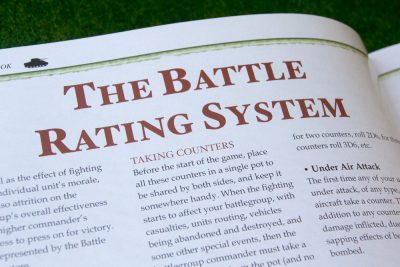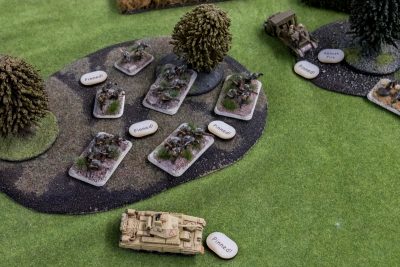Battlegroup: How to win by Chitting
by Troy A. Hill
Photos by the Author
I’ve recently begun a series that looks at the . This piece will look at some basic rules of the game. All page references are from the Battlegroup Rule Book, hardcover revised edition.
Winning the Game:
The first question a player asks of any game is: “how do I win” (or lose)? In Battlegroup, there are several ways: controlling all objectives at the end of your opponent’s turn, causing the opposing force to be destroyed or pinned so they cannot use any orders on their next turn, or (as

occurs most often) when your opponent’s Battle Counter Chits sum exceed their force’s Battle Rating.
Battlegroup uses a secret countdown of these Battle Counter tokens as a core mechanic. During the course of the game, players will be required to blindly draw morale “chits” from a bag or cup. These chits range up in value from one to five points each. Typically, there are more of the middle numbers (two and three) than there are ones and fives in the pool of chits. There are also special chits, with beneficial effects for the one who draws them. I will cover these more in a later piece.
When the numbers on the chits exceed the Battle Rating of the player’s force, their force breaks and runs. Their opponent celebrates the victory. Tying your battle rating, instead of exceeding it, with chit values is not a loss. But, you’re very, very close.
Chits are normally kept in a bag or cup for blind draws from the pool.The two most common triggers for chits to be drawn are unit casualties, and unpinning. In Battlegroup, a single vehicle, such as one Sherman tank, is typically considered to be a single unit. Deployed guns, whether they are AT guns or Artillery such as a 25 pounder, are also one gun equals one unit. Therefore, destroying a tank, or a deployed gun is the loss of a unit. The player who suffered the loss then draws a chit. Infantry units are composed of several men per unit (explanation of unit on pg. 7). An infantry unit might be a squad, a section, or a team with a weapon, such as a 3-man MG team. For example, a Canadian Rifle Section (pg 109 in the BG rulebook) is composed of 10 men and includes one Bren Gun in their section. Since I’m repurposing my Flames of War models, I use two 5-men medium bases of infantry. The platoon for the Canadian Rifles has one five-man stand for its command team,65 and three 10-man units. The platoon also includes a 2-inch mortar team, as the fifth unit.
The photo above shows seven different “units” from the sample Canadian list. The two blue stands are one unit of 10 men. The green stands are another unit of infantry. The two three-man stands make up the platoon command unit (we’ll mark that it’s only five men, not the six depicted). The 6-pdr portee is another unit, as is the Churchill, the 6pdr deployed gun, and the Crusader. Each vehicle or deployed gun counts as one unit (unless the army list in the theatre book indicates differently for that force).
Comand Unit (5 men)
Rifle Section 1 (10 men = 1 unit)
Rifle Section 2 (10 men = 1 unit)
Rifle Section 3 (10 men = 1 unit)
2-Inch Mortar Unit (2 men + 2-inch Mortar)
The key to understanding this is to look at the Battlegroup army list for the platoon. The word unit pertains to how component pieces of each platoon. The composition of each unit in the platoon, or each support unit, is laid out in the army list sections of each theatre book (or the sample lists in the Battlegroup rulebook.
During the course of the game, the units may come under fire, and suffer casualties. We use dice or markers to show the wounds suffered by each stand. If you base your figures on single bases, simply pull the figure off the table when it becomes a casualty.
In the Canadian Rifle Platoon above, if all stands/models in my green unit are destroyed (10 men) then I would draw a morale chit, and add its points to my “bad” pool. When the total value of the chits drawn exceeds my force’s Battle Rating, my troops have had enough, and any left on the table flee and give victory to my opponent.
Even though you’re to keep your battle counter score total secret, you and your opponent will know how many individual counters each has drawn. But, you won’t know the total value of the chits the other has drawn. As long as your total doesn’t go over your force’s battle rating, your force can keep fighting (with a few exceptions).
Battle Rating
So, what’s this mysterious Battle Rating that these chits stack up against?
Just as in other wargames, players build their forces to a predetermined points level. Each part of the force will cost X points. One shouldn’t confuse the point cost of a force with it’s Battle Rating. Those two numbers are independent of each other.
For most lists, the various units and weapons and vehicles in your force will have both a point cost, as well as a Battle Rating. You and your opponent would agree on a point level to design your force to. Once you compile the force using the point cost, you then total the Battle Rating (BR) for each part of your force. Keep the BR total separate from the point cost of the unit.
For example: In the basic Battlegroup rulebook, the Canadian Rifle Platoon (pg 109) would cost 94 points and have a BR of 11.
The BG rulebook gives sample army lists pulled from the Overlord book. Theatre specific books present force lists specific to the theatre each book covers. Points and battle ratings are provided for each unit/platoon.The German forces have (page 116) an Armoured Panzer Grenadier Platoon that costs a whopping 120 points but also has a BR of 11.
The designers have a brief explanation (pg. 48) to explain how BR isn’t related directly to the point cost of the unit. Instead, it’s more closely tied to how important that unit can be to your forces. In addition, units have an Experience Rating. These are Inexperienced, Regular, Veteran, and Elite. The experience of the unit also figures into both the point cost and the BR for the unit.
Troops and weapons on the table generally add to your force’s BR. Artillery, which is generally off the board, does not typically add to the force’s BR.
Drawing Chits
There are several reasons a player may need to draw a counter or chit from the bag. The main reasons include suffering a unit loss, or to get an unpinning die or dice.
As you and your opponent play, you’ll find ways to force each other to draw chits. Again, you’ll keep your chit sum value total secret. But, you’ll observe how many chits your opponent draws, and they’ll see how many you draw. This gives you a sense of how close they are to their Battle Rating being exceeded. Only you know your exact point total.
Unpinning
The other most common reason for drawing a chit is to unpin your troops.
Need to unpin some troops or AFVs? At the end of your turn in the Rally phase, announce that you’re unpinning, and announce how many chits you’re going to draw. Each chit drawn gives you 1d6 of units you can unpin automatically. But, don’t draw so many chits that you exceed your BR.In order to unpin troops in the Rally (final) phase of a player’s turn, they survey how many units are pinned. They may “purchase” one or more d6s, roll it, and unpin however many units the d6 roll gives them. Remember, each AFV is usually one unit. One gun is typically one unit. Infantry can vary in the number of men per unit. In the Canadian Rifle example above, 10 men are one unit.
To “purchase” a d6 unpinning roll… they DRAW A CHIT!
I bet you didn’t see that coming! 😉
At the end of a turn, a player decides how many chits they’re willing to draw. Each chit drawn gives a player one d6 to roll to unpin. The player announces how many chits they are drawing, make the draw, then roll one d6 per chit they drew that Rally Phase. Then they hope they don’t exceed the Battle Rating with the new chit values. The sum of the dice they roll is how many units they can unpin that turn.
For example. My force has a BR of 50. If my chit value is currently 43 points., I can safely draw one chit (max value of 5). Doing the math means 43+5 is still under 50. I won’t lose by drawing one chit. I might be able to get away with drawing two chits… but, that might also cost me the game. If the chits I drew total eight points or more, I’d lose (43 + 8 = 51, which is more than my Battle Rating).

I draw a chit, it has a value of 2. New BR is now 45.
Then I roll 1d6 and get a 4.
I can automatically unpin 4 units. Now, I would have to decide which of my five pinned units to leave pinned. Keep in mind, my opponent gets to begin his turn immediately following my unpinning. Those units may get pinned again before I get to give them orders.
Another way to Unpin
A senior officer (eg: the 1iC) can draw a chit and use the Tactical Coordination order. Basically, they chew out the troops and get them moving again, and remove the pinned status. But the unit in question has to pass a Unit Experience Test (more on this test in a later piece) for this to succeed. This tactic is useful when a player needs a pinned unit to do something that turn, and not wait until the Rally phase at the end of their turn.
In this case, I’ll be sure to unpin the Portee, since it won’t be able to use it’s “Ambush Fire” order in my opponent’s turn if it’s still pinned.Other ways to draw a chit
There are several other reasons that a player would need to draw a chit; coming under a specialty attack for the first time – such as an air attack or a flamethrower attack – being out-scouted at the beginning of a game, or losing a senior officer. If players are using objectives, then having your opponent capture an objective would require you to draw a chit. The full list is on page 48.
Overall, I’ve found the shift to using a Battle Rating and the blind and secret draw to be an interesting mechanic in this game. It adds an element of suspense, while still allowing players to play with a wide variety of play styles (aggressive or cautious, fast attack or defensive, etc). And, my gaming friends love to yell “Toss me the chit bag!” whenever they’re required to draw a chit.
Troy is a long time gamer, and the author of the medieval fantasy series. He’s also the dude who strives to keep the typos under control on No Dice No Glory.

Awesome! Thanks!
More Battlegroup please! Do you find the BR system well balanced?
Thanks John. I do like the balance in BG. Unfortunately, my area of Los Angeles seems to be Flames or Team Yankee heavy. So my play time is limited with this game.
If you haven’t already, jump into our forum (link at top of page). We’ve got a section just for Battlegroup there.